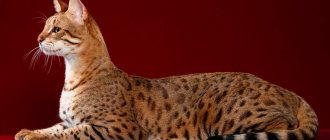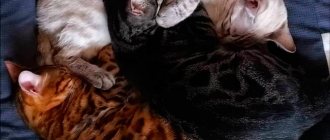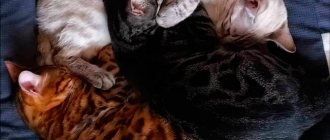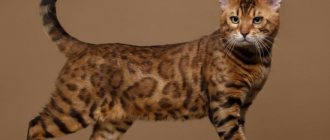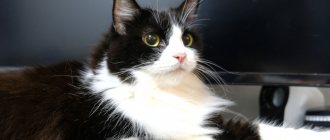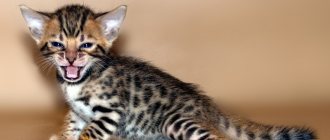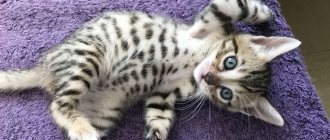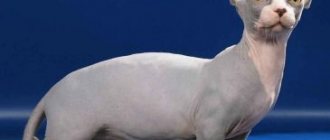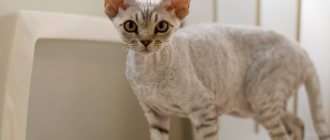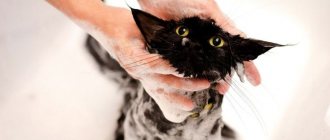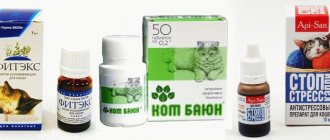Basic information
| Breed name: | Bengal cat |
| Country of origin: | Southeast Asia |
| Period of appearance of the breed: | 1961 |
| Type: | Home |
| Average weight: | 2.5 - 7 kg |
| Height at withers: | 15-30 cm |
| EMS code: | BEN |
| Average life expectancy: | 12 – 25 years |
| Prices for kittens: | 1000 — 2500 $ |
| The most popular nicknames: |
Mr. Cat recommends: description, characteristics, habitat
In nature, wild cats are found on islands in Indonesia, the Amur region, and Asia, where they are represented by numerous subspecies. They adapt well to different conditions: forests, plains, taiga. They prefer places near water sources, but away from human settlements. Avoid desert areas without vegetation. They are found in the mountains at an altitude of 3 thousand m above sea level, on rocks and rocky outcrops.
The color and pattern on it changes depending on the habitat. The main color tone is shades from yellow to gray-brown. The chin, chest, and belly are almost white, and the end of the tail is black. Dark spots are scattered throughout the body: circles, smears, or collected in rosettes. The drawing can stand out strongly against the background or be almost invisible.
The length of the elegant strong body is 75-100 cm, the tail is almost half, the height is 39-41 cm. Weight is 3.8-7 kg. Males are larger than females. The coat is thick, soft, and short. The head is small in size with a narrow muzzle. The ears are rounded without tufts. The eyes are brown, large and round. The tail looks like a carrot.
They live in nature for 12-15 years. The voice resembles that of a domestic cat.
Estimation of breed characteristics
| Adaptability: |
| Shedding level: |
| Social need: |
| Grooming: |
| Ease of care: |
| Attachment to family: |
| Hair loss/shedding: |
| Health/susceptibility to disease: |
The selective breed of Bengal cats, which appeared a little more than half a century ago, has a unique color and special disposition. So far, the small population in the world is in demand and is actively developing. A Bengal cat of any color looks very exotic.
Need for care
For the owner of a Bengal cat, caring for your pet will not be a serious problem. It will be enough to comb the coat once every couple of weeks with a soft brush, and trim the nails several times a month. It is enough to wash your pet as needed; most of the time you will have to make sure that the cat does not get into the water. And caring for your eyes and ears involves monthly examination and monitoring of their condition.
Photo: @mars_mr_cat/Instagram
But there are several features:
- A leopard-colored pet's tray should always be clean - they will not go near a dirty area, even if they are in great need.
- It is necessary to brush your teeth weekly from the moment the kitten arrives in the house to prevent the formation of tartar and oral diseases.
- It is imperative to equip a corner for the pet - its territory must be inviolable for the owner and be a bed or a house (the second option is a priority).
- The quality of food should always be monitored especially carefully, since the breed has sensitive digestion.
Description of Bengal cats
The modern breed of Bengal domestic cats originates half from Southeast Asia, where the wild Felis Bengalensis has a natural habitat. The second ancestor of this hybrid is an ordinary domestic black American cat from the Abyssinian breed. The offspring turned out to be not only very viable, but also beautiful in their spotted bright color, just like in the wild. Read separate articles about how long domestic Bengal cats live with proper care and what characteristics they have.
History of Bengalis
The history of the domestic Bengal breed began with the purchase of a wild forest cat kitten in Bangkok. A female named Malaysia, brought to America by Gina Sugden, despite her unsociable disposition, formed a pair with the owner’s cat. The further origin of the breed and the development of subspecies are described in a detailed text.
Read more about the history of the Bengal breed
Standards
Bengal Smooth-haired cats are a muscular and robust breed with sizes ranging from medium to large. The nocturnal predator of the forest is identified by a wide nose, large almost round eyes, and expressively convex whisker pads on the relatively small head of Bengal cats. The profile of the head is almost straight, only slightly concave. Wide-set, relatively short ears with rounded tips give the animal the characteristic appearance of a unique breed. The coat is short and dense, surprisingly silky-soft to the touch. The Bengals' look is completed by a thick, medium-length tail that hangs down.
The parameters of Bengals approved by classifiers of international organizations (FCI, WCF TICA, etc.) are as follows:
— a modified wide wedge is defined for the head, the contours of which are rounded;
— the face is characterized by a strong chin , protruding pads under the whiskers, high pronounced cheekbones, the cat is not lop-eared;
— for the neck, the proportion to the body and head is important: strong, long, muscular;
- for the body, the definitions should be slightly larger or of medium length, powerful (the bones are solid, not refined, with strong paws).
The standards stipulate separately the temperament of Bengals: a male cat may show fear, try to escape, scream loudly, but should not show the slightest aggression. Any threat from an animal is a disqualification.
Colors and coat of an elite Bengal cat
You can learn more about the types of coat colors of Bengals in additional texts; here is a list of the main ones for purebred representatives:
1. Brown Tabby - brown with a distinct pattern ben n24 allows for variations in color, but tones with a significant amount of ruffism are preferred;
2. Seal Lynx Point - dark brown markings on an ivory or cream colored background;
3. Seal Sepia Tabby or Seal Mink Tabby - Burmese or Tonkinese patterned with distinct spots on a lighter coat:
There are also several silver, blue, smoky, snow, black colors: Black Silver Tabby, Seal Lynx Point, Seal Silver Sepia Tabby, Seal Silver Lynx Point, Seal Silver Mink Tabby. Color subspecies are not recognized by all phenological structures - for example, the magnificent melanistic black Bengal cat is listed in TIKA as “Non Standard”.
Standards for the coat of Bengal cats: close-fitting, short to medium in length (longer in kittens), dense, unusually soft and silky to tactile perception. According to the configuration of the pattern, they are distinguished between spotted (Spotted) and marble (Marbled). A brindle horizontal stripe pattern is allowed on the legs and tail.
Read more about the colors of Bengals
Appearance
Representatives of the breed can have a medium or large size, they look like real predators in miniature: a muscular, proportional body, keen, expressive eyes, strong developed limbs. An adult male can reach a weight of 8-9 kg, females are slightly smaller, up to 5-7 kg.
The head is elongated, the muzzle is powerful, located proportionally on the head. The legs are muscular, the paws are powerful, round in shape. The tail is not very long, round with a rounded tip.
The eyes are oval-shaped, set at a slight angle. The color can be any, with the exception of blue, depending on the color. There is a variety of snow-white Bengals whose eyes are exclusively blue.
A wide, large nose, the lobe of which is slightly upturned. The whisker pads are clearly visible. The ears are short, with rounded tips, and small in size. Bengal cats have thick, short hair that is silky to the touch.
According to accepted standards, Bengal cats can have two types of coat patterns: marbled or spotted (rosette). The outlines of spots, rosettes or marbling should be clear.
Spots can come in a variety of shapes. It is desirable that the fur on the belly be lighter, a pattern in the form of a necklace is required on the neck, and the same rosettes or rings should be present on the tail, ending with a black tip.
One of the largest felinological organizations, TICA, recognizes as standard colors such as charcoal, blue, silver tabby, brown tabby, and snow (there are three shades - sepia, lynx and mink).
During the selection process, Bengals acquired two characteristics, called by the English terms glitter (shine) and fuzzy (fluffy, covered with fluff). The glitter feature is entrenched in the Bengal breed, although not all representatives can boast of such stunning shiny coat. However, mostly Bengals sport a silky coat that truly shines and shimmers, as if it had been sprinkled with the smallest scattering of sparkles.
Fuzzy is a feature of Bengal kittens, which consists in the fact that at the age of about 1-1.5 months they begin to grow a rather long outer coat, which makes them fluffy, and the patterns of the main coat a little blurry. By 8-9 months, the long hair disappears, the kitten becomes the very same Bengal: with short hair, on which a clear pattern is clearly visible.
Personality of Bengal cats
The character of the selective elite Bengal cat harmoniously intertwines the predatory temperament of the forest animal prionailurus bengalensis with the disposition of a domestic animal. Bengal cats and kittens have a wild hunting instinct, their habits have become dulled, but have not disappeared. From early childhood to any age, they play “hunt and chase” - chasing toys, balls, catching flywheels, chasing light pieces of paper, rustling bags. As a result, even at a young age, the Bengal cat easily learns to catch mice. They get along well in a pack, but do not become depressed without companions. However, when straying from home, or when kept in an enclosure, they quickly run wild. Representatives of the breed are not aggressive, get along well with children, are loyal and affectionate if the kittens are taught to be affectionate and handled. They get along with other pets, except birds and rodents. Their specialty is talkativeness. There are two separate articles about this - “What sounds does a Bengal make”, “Why do Bengal cats yell”.
More about the character and habits of Bengals
Diet
Typically, wild Bengal cats feed on small game, such as mice, rats, hamsters, rabbits, squirrels or birds.
During periods of hunger, the animal can hunt various reptiles, insects, and small animals. Sometimes they can fish, but most often they hunt on land, since their color helps them in such conditions.
If a wild animal finds the eggs of other animals, then it will eat them too.
For domesticated wild Bengal cats, you need to choose a special diet. It must be balanced and contain all the necessary vitamins, minerals, and macroelements.
The animal can be fed with special balanced feed. But it is very important not to focus on them, but to give them more meat and other natural foods.
Industrial feed
The digestion of Bengals is quite difficult to tolerate a change in diet. Buy good, expensive industrial food. It is completely unreasonable to buy a pet for a lot of money and then spoil its health with bad food.
The food must be of the highest quality. It is best to ask the breeder what food you can feed your little leopard. It is important that a cat on such a diet always has fresh water. It is best to buy electric bowls in which the water is constantly renewed. This will resemble a pond or stream and will inspire more confidence.
Natural food
But it is best to feed the animal with natural food. Many people believe that if you feed a predator meat, it will become even more wild. This is wrong. Such an animal really needs raw meat, since only through it can the cat receive the necessary elements.
The meat can be anything: chicken, beef, fish. You can add porridge (without milk) and boiled vegetables to your diet.
Wild bengal in an aviary
Features of Bengals
The characteristics of Bengal cats and cats are due to the origin of this rather young hybrid breed. Bred by intergeneric crossing with prionailurus bengalensis, the domestic animal has a unique color, inherited from Asian leopard cats, and also has a special character. The advantages, in addition to the magnificent color, include:
- sociability, playfulness;
- the ability to get along, while maintaining dominance, with other animals (not birds or rodents);
— cleanliness;
- ease of care and feeding.
Among the disadvantages, breeders and ordinary cat lovers cite the habit of meowing loudly, a tendency to inflammation of the gastrointestinal organs, as well as the high cost of a noble breeding breed. About the size and weight of the Bengal leopard cat - in a separate text.
Read more about the size and weight of Bengals
Advantages and disadvantages
Advantages of the breed:
- attractive exterior;
- calm character;
- friendliness;
- love;
- high intellectual abilities;
- ease of care;
- excellent health;
- intelligence;
- ability to train;
- good manners.
Flaws:
- representatives of the F1-F3 generation have a bad character;
- waywardness;
- desire to defend personal boundaries in a slightly aggressive manner;
- a developed hunting instinct poses a threat to small animals, fish and birds;
- high cost.
Keeping and caring for Bengal cats
The great advantages of Bengal cats and cats include their undemanding maintenance. Having purchased a basic set of cat supplies and taken care of two or three scratching posts, you won’t need anything else “special”. The second advantage is short, non-shedding hair, which should only be combed from time to time. The Bengal easily gets accustomed to water procedures and household routines - he will not refuse to bathe. Read more about caring for Bengal cats here.
Read more about keeping and caring for Bengals
Grooming of Bengal cats
Like other short-haired breeds, Bengal shorthairs do not need a haircut, and brushing the coat is an infrequent procedure (once every 2 weeks), washing is even less common. However, this descendant of forest predators has strong, sharp claws - they must be trimmed even when actively walking, or if there are claw sharpeners with different textures in the house. The animal is removed with sharp tweezers only from the very tip of the already bent claw. The pet should be in a complacent and relaxed state at this time. If you injure your cat (by touching living tissue), you should immediately moisten the claw with hydrogen peroxide.
The purring ears' small ears need regular cleaning of wax - the easiest way to do this is with a cotton swab soaked in petroleum jelly.
The expressive eyes of the Bengal cat require washing from time to time, and if there is excessive mucus secretion or souring of the eyes, veterinary care is needed.
To avoid gingivitis (inflammation of the gums), brush your teeth about once or twice a week with a special cat toothpaste.
Simple procedures, and most importantly, attention to the well-being of the tailed pet, guarantee a magnificent appearance for the Bengal.
What to feed a Bengal cat
The pet’s quality of life – health, exterior beauty, longevity – is directly dependent on a competent and varied diet. Bengalis, who have sensitive stomachs, find it difficult to experiment with food items and cooking methods. Cheap economy food for an expensive cat is nonsense. There are two (main) options: high-quality food prepared by an industrial brand or balanced natural nutrition. You need to be very careful with this breed in a mixed menu. Read more in the article “Feeding Bengal cats.”
Natural nutrition
With all the advantages included in the concept of “natural products,” there are disadvantages: keeping track of a balanced diet is not easy. The entire list of vital ingredients in a cat’s diet will have to be tracked using a specially kept diary. A complete list of dishes and additives in them is in the detailed article “Feeding”.
Ready food
The very definition of “ready-made food” makes the task of properly feeding a Bengal cat 90 percent easier. It is important to observe portion sizes and frequency of meals. The manufacturers have thought about, weighed, and calculated the balance of branded food (Bengals shouldn’t even offer anything else!).
Features of feeding
In addition to the usual age-related features of feeding babies and feeding adults, Bengal cats have a tendency to have poor tolerance to a number of foods and general instability of the functionality of the gastrointestinal tract. Therefore, it is recommended to very carefully offer animals new natural and canned products, and to transfer the food menu from one manufacturer to another according to the scheme (see the text “Feeding”).
Read more about feeding Bengals
Domestic spotted cats
The spotted tabbie color can be found in cats that are not closely related to wild predators.
Ocicat
Ocicat
Ocicats appeared as a result of crossing the Siamese breed with Abyssinian cats. The cats owe their name to the breed because of their cream-colored fur with golden spots, giving it a resemblance to a wild Ocelot. The character of the pets is soft, affectionate, playful, sociable.
Egyptian Mau
One of the oldest cat breeds, tracing its ancestry back to the domestic cats of Ancient Egypt. It is distinguished by short, dense fur, decorated with dark markings. The shades of the fur coat can be different - silver, “haze”, tin, bronze. The distinctive mark of the fluffies is the scarab beetle symbol on the forehead and a dark rim around the eyes.
Egyptian Mau
Egyptian Mau are distinguished by their medium-sized muscular body and calm and harmonious disposition. Pets become attached to their owner, suffer alone, are friendly, sociable, and talkative. The set of sounds made by animals is reminiscent of human speech.
Pixiebob
Pixiebob Photography
The breeders who created the Pixiebob sought to breed an animal that resembled a miniature lynx. For this purpose, genetic material from forest cats from the North American continent was used. Pixie Bob's distinctive external features are sideburns, a short ponytail and tassels on his ears. The coat is covered with a spotted pattern in the form of “rosettes”. Pets are affectionate to people, distinguished by deep devotion, friendly, sociable, and talkative. They love acrobatic exercises, love water procedures, willingly swim, and participate in children's games. Pixiebob gets along well with other four-legged pets, but always strives to take a leading position.
British and Scots
Scottish straight
The British and Scottish breeds are not very different genetically, although they are registered as separate varieties. Pets are characterized by common character traits - phlegmaticity, restraint, noble manners, cleanliness. Among the variety of colors, you can often find colors with spots of various shapes.
Shorthaired Pointer (American Shorthair)
Kurzhaar
Cats of this breed are distinguished by their muscular build, strong paws and developed hunting instinct. The most popular American color is silver tabbie (large dark markings on a silver background). By nature, pets are the “golden mean” - moderately playful, balanced, devoted to their owners, but without excessive intrusiveness.
European Shorthair
Photos of the Siberian cat breed
The European Shorthair's thick, short coat is flexible and shiny. This oldest native cat was registered as an official breed in the early 1980s. Kind and affectionate pets enjoy playing with young family members.
Siberian
Due to the natural origin of the breed, Siberians are distinguished by good health, physical strength, endurance, and energy. The long coat with a thick undercoat has water-repellent properties. The character of the Siberian cat is balanced and independent. Fluffy beauties sincerely become attached to their owners, but do not tolerate intrusive attention. Spotted coloration is quite common among Siberians.
Maine Coon
Maine Coon
One of the largest domestic cats in the world. The length of an adult male from head to tip of tail reaches 1.5 meters, and weight – 15-16 kg. The behavior of cats is reasonable, restrained, harmonious. From their wild ancestors, Maine Coons inherited extraordinary hunting abilities. Among other colors, spotted is quite common.
Health and diseases of Bengal cats
The health of Bengal cats is considered a complex topic. The breed, on the one hand, has strong genes from wild forest ancestors, but on the other hand, it was formed through closely related breeding, and this has a negative effect. Generally speaking, Bengal cats suffer from only a few typical diseases, as discussed in the corresponding three sections “Diseases and Health”, “Puberty of the Bengal”, “What you need to know about castration of a cat”. You can prevent the likelihood of pathologies by monitoring the condition of the animal, undergoing annual or as needed examinations from a veterinarian, and vaccinations (vaccinations), sterilization or castration done on time.
Read more about the health of Bengalis
Price
The price of Bengal cats varies from 15 thousand to 150 thousand rubles. All this depends on the purpose of buying a pet: for home care or visiting a variety of exhibitions. Bengal cats are divided into 3 main types:
- pet class: pets that are bought for the home have severe defects in appearance due to an unclean pedigree; cost 15 thousand;
- breeding class: animals with minimal, almost imperceptible problems in appearance and behavior, which cost 60 thousand;
- show class: real elite cats with ideal appearance, which are bought exclusively for exhibitions and breeding; cost at least 100 thousand.
Personally, I have the most ordinary pet class. Yes, the cat’s tail is a little short and his ears are not so pointed, but this in no way spoils his stunning beauty and grace, and because of this I never stop loving him.
Bengal cats are graceful animals that have a lot of positive traits. Raising such a pet is pure pleasure, because it hardly causes any problems for the owner. Over the past 5 years, I have never regretted that I bought the Bengal cat Chuck, because he is a great friend and a loyal companion.
Pregnancy and childbirth
The gestation period for the Bengal cat is normal for the species - about 65 days. They count down the days from the moment of successful mating, which will be indicated by such indirect signs as the cessation of estrus, changes in behavior. An ultrasound confirms the presence of kittens in the uterus after 15 days. Bengal cats usually give birth on their own; assistance may be needed during the first lambing. However, it is recommended to undergo an examination and adhere to the advice of a veterinarian. You can read more about pregnancy and childbirth.
Read more about Bengal pregnancy
Puberty and reproduction
Puberty in a wild Bengal cat occurs at 1.5 years. To raise offspring, these cats unite in pairs. The female looks for a safe place for the den and arranges it. In the southern regions, mating is possible at any time, in cold regions - in the spring, when it gets warmer and conditions become favorable for raising kittens.
The gestation period is on average 66 days, after which 2-3 kittens are born, less often - 4. They begin to see at 10 days, and within a month they already leave the shelter and begin to get acquainted with the surroundings. They are fed milk; from three weeks of age they are accustomed to eating meat. Both parents are involved in raising the younger generation. Kittens leave them 10 months after birth.
Kittens
Bengal kittens stay with their mother for at least two and a half to three months. This period allows them to get stronger physically, socialize, and receive a mandatory package of vaccinations. Moving to a new home and separation from relatives inevitably greatly frighten the baby with noise, smells, and movement in the carrier. The owner will need attention and patience: it is not easy for a kitten to make new contacts and get used to unfamiliar housing. The articles “Caring for a kitten”, “Food for Bengal kittens”, “Education, training”, “Colors of kittens and phasing” contain recommendations regarding all processes of communication with little Bengals - funny in their hunting habits.
Métis
There are significant features in breeding the Bengal cat breed. They currently do not have officially recognized mestizos due to the ban of felinological communities on crossing with other species. There are also few unofficial “derivatives” based on Bengals; sometimes it is difficult to recognize and distinguish them from the real ones. The recently bred cashmere (or silk) Bengal with long hair, which has become more and more loyal to specialists over the years, has shown that there is a “dormant” gene for long hair in the gene pool of the hybrid. A special text is dedicated to the mixed breeds of the Bengal cat.
Who are Bengal pussies suitable for?
Despite the increased popularity of pet leopards, these pets are not suitable for everyone. Good reviews about Bengal cats can be read on forums, mainly from experienced owners. Pussies with such a character are not suitable for people who love peace and quiet, since in this case the pet will require a lot of attention. Bengals are actively purchased by allergy sufferers, since the presence of a pet leopard in the apartment reduces the likelihood of allergic attacks.
Upbringing. Training
The independent nature of Bengals does not mean that they will not obey. Using short, strict “no” orders in parallel with a gentle pinch on the neck that is understandable to the animal (this is what cat mothers do when raising kittens), you can achieve compliance with order. The easiest way to reach a consensus on following the rules is based on the instincts and desires of the pet itself. To do this, at the first “observational” stage you need to notice how the cat behaves. Habits, preferences, behavioral characteristics are then used in choosing educational methods.
More than other cats, Bengal cats will not tolerate violence, so pedagogy a priori involves encouragement, affection, and is built on complete trust. Educational processes must begin at a very tender age - read the article “Upbringing and training” about this.
Are Bengals a friendly breed?
These cats are quite friendly, but will not happily greet strangers. At first they will be distrustful, but they will quickly get used to the guest and will fawn on him.
Photo: @leonardo_the_bengal/Instagram
It is also worth noting that the Bengal breed is not known for its aggression; it does not have this quality at all. Even if cruelty is shown by an adult or child, the likelihood of a retaliatory attack is almost zero. There is a greater chance that the cat will try to dodge the unwanted influence on itself and run to hide in a secluded place.
Mating, breeding of Bengal cats
Bengal cats are a “late” breed when maturing. Although females usually go into heat before they are a year old, not earlier than 8 months, sexual maturity begins only at 11-12 months. The advantage of the breed is the stability of the processes; cycle disorders in healthy Belgian cats rarely occur. But the choice of a partner is a problem in the competent mating of representatives of a species that is a little more than half a century old. There are only 5 lines from the first generation F1 (f1). Read two separate information about mating and breeding of purebred Bengals.
Read more about breeding Bengals
Where to buy a Bengal cat or cat
A purebred cat, similar to a jaguar, but with soft fur, almost like a chinchilla, is a real decoration of the house, an object of aesthetic pleasure and relaxation. The small population due to the youth of the species makes the only correct decision to buy a kitten from an official nursery. This is the only way to get a representative from professionally selected, necessarily the best manufacturers who have all the documents. Detailed recommendations here.
How much does a Bengal kitten cost?
Breeding Bengal kittens still requires painstaking selection and significant financial investments to purchase studs. As a result, the price of each baby that meets the standards is high. When faced with an offer to purchase Bengals at a price below 35-40 thousand rubles, you should reasonably suspect a catch.
It will either be a mixed-breed Bengal, or a defective specimen, or without the proper pedigree. Depending on the title of the mother and father, the level of the nursery, and the characteristics of the kitten itself, the cost can be above 40 thousand. Read the text “How much does a Bengal cat cost?”
Interesting facts about Bengals
1. Representatives of the Bengal breed love water - a feature inherited from wild ancestors who still live in Asia, rich in various bodies of water.
2. Initially, the breed was included in the lists of cat associations with the name “safari”, and was rightly renamed in honor of the wild Bengal ancestor, which it resembles.
3. For the first time, Russian admirers of purebred cats saw a French Bengal named Lucia at an exhibition in 1997. Soon, foreign exotic-colored representatives of the breed registered in Moscow felinological clubs.
4. Bengal cats are a “talkative” type of cat. The vocabulary and sound reserve includes not only the usual meowing and purring, but also such unusual sounds as clicks, growls, and trills.
Exhibitions
The first exhibition in the biography of the Bengal cat after the standard was adopted for it in the early 1990s was the TICA championship. Jane Mill with her absolutely tame “leopard” was a resounding success. Following the premiere, the triumphant march of the new breed around the world began. Although there are no separate international exhibitions for Bengals (except for nursery and club shows), they have repeatedly won cat championships. Russian representatives also have success: the Muscovite Oldrace Oscar is included in the TOP-3 best Bengal cats in the world according to the WCF system.
History of the breed
New breeds of cats are created through painstaking selection, which makes it possible to obtain offspring with certain characteristics of the parent pair and consolidate the result of natural mutation. The Bengal cat was born thanks to the enthusiasm and hard work of Jane Mill. While a student at the University of California at Davis, Jane got the idea of creating a breed by mating Siamese and Persian cats.
However, she did not receive the support of her supervisor, who considered the idea “frivolous” and advised Mill to work on creating something practical, suitable for rural or livestock farms. Jen listened to her supervisor, but did not forget about the idea.
In 1961, Mill visited Thailand, where she saw wild leopard cats and immediately fell in love with these big-eyed creatures. There she learned that the species is on the verge of complete extinction due to hunting for their amazingly beautiful fur. Wanting to save the life of at least one beauty, Jane bought a cat and brought it home, where her outbred black cat took a liking to it.
The owner did not make any plans to get offspring, but a couple of purring lovers decided in their own way - a cat named Kin-Kin was born. Later, she gave birth to two kittens: the baby did not inherit the exotic color and turned out to be an evil creature, and the boy accidentally died. Kin-Kin herself had no more offspring and died of pneumonia.
At this point, experiments on breeding a new breed could have stopped, but fate decreed otherwise. Loma Linda University Medical Center conducted research on the treatment of leukemia in cats. For this purpose, litters were bred from domestic cats and male Asian Leopard Cats. The latter have demonstrated amazing resistance to this disease.
Project leader Dr. Willard Centerwall placed several first-generation babies under Mill's care. At this stage, a new task arose - where to find suitable partners for further breeding. Well-known and popular breeds (Abyssinian, British, Siamese) had genetic pathologies and were not suitable for participation in the experiment, so Jane decided to go to India.
In New Delhi, she accidentally saw a golden-red spotted kitten, which she named Tori. The handsome man passed on to his descendants the stunning bronze color and dazzling shine of his coat. Later, Jane received several more cats from India. Today this is the recognized “Indian lineage” of the Mau.
Many American breeders of Egyptian Mau and Ocicat cats opposed the registration of the new hybrid breed. Perhaps they were afraid of the appearance of “wild blood”, or out of envy of Mill’s success they tried to put a spoke in the wheels.
As a result, Bengal cats were not registered with The Cat Fanciers' Association for a long time, although in 1983 the breed received recognition from TICA. Since 1985, Jane Mill's "children" have taken part in national exhibitions and received well-deserved ovations from experts and spectators.
Selective work on Bengals continued until the 90s. The breeder managed to obtain several more productive lines after attracting new male leopard cats. Work to improve the breed is still ongoing. Breeders try to cleanse animals of “genetic debris”, which manifests itself in a monochromatic color, long hair, and unwanted ticking.
Interesting. Bengal cats receive high marks from experts at international exhibitions and regularly find themselves in the top 25 “best cats in the world” according to The International Cat's Association.
